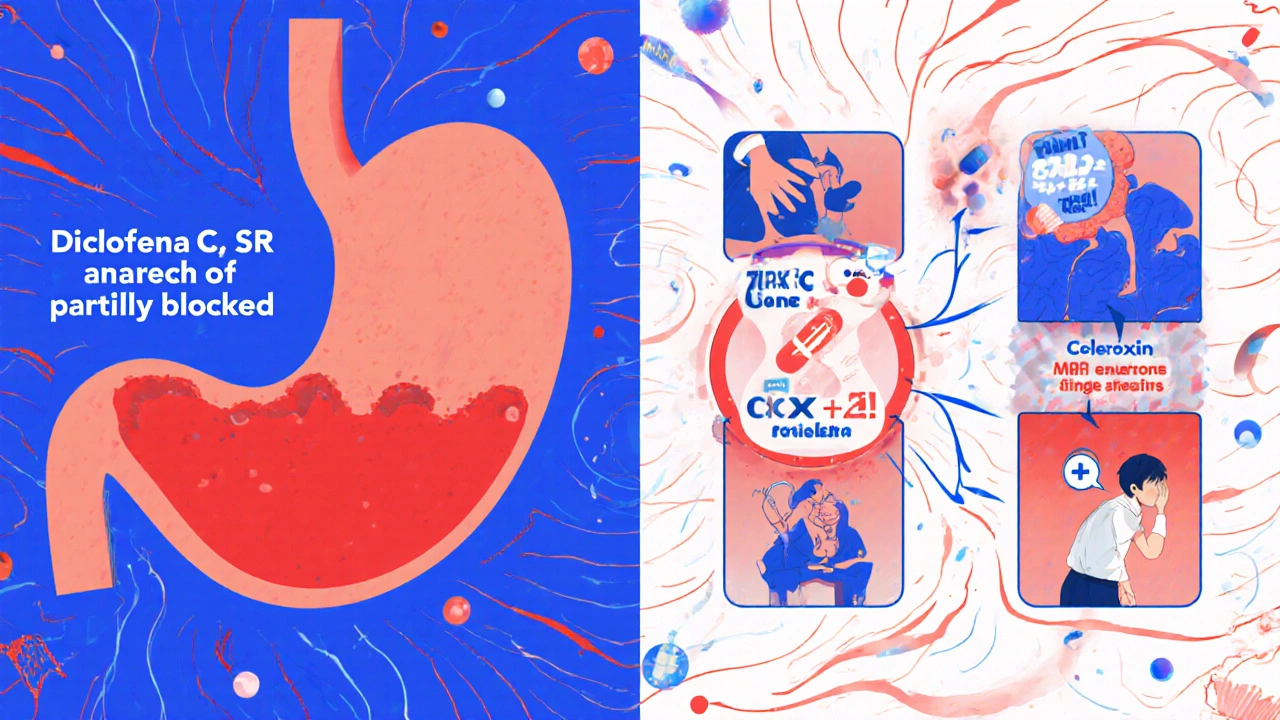NSAID Selection Advisor
Find Your Best NSAID Match
Answer a few questions about your situation to get personalized recommendations based on the comparison in the article.
Your Recommended NSAID
Why it's recommended for you:
Key Benefits
Important Considerations
When it comes to managing moderate to severe pain or inflammation, doctors often turn to non‑steroidal anti‑inflammatory drugs (NSAIDs). Diclofenac SR is one of the extended‑release options that promises steady pain relief over 12‑24 hours. But is it the right pick for you, or does another NSAID fit your needs better? This guide breaks down Diclofenac SR, lines it up against popular alternatives, and gives you the facts you need to decide.
Key Takeaways
- Diclofenac SR delivers consistent plasma levels, making it useful for chronic conditions like arthritis.
- Compared with naproxen and ibuprofen, Diclofenac SR often shows a slightly stronger anti‑inflammatory effect but carries a higher gastrointestinal (GI) risk.
- Celecoxib, a COX‑2‑selective NSAID, reduces GI side‑effects but may raise cardiovascular (CV) concerns.
- Meloxicam offers a middle ground: once‑daily dosing with a lower GI profile than Diclofenac.
- Choosing the best NSAID depends on your medical history, drug‑interaction profile, and cost considerations.
Diclofenac SR is an extended‑release formulation of diclofenac sodium designed to release the drug slowly over 12‑24 hours. It belongs to the arylacetic‑acid class of NSAIDs and works by inhibiting cyclo‑oxygenase enzymes (COX‑1 and COX‑2), which reduces prostaglandin synthesis-those chemicals that drive pain, swelling, and fever.
How Diclofenac SR Works
The extended‑release matrix allows the drug to maintain therapeutic concentrations with once‑or twice‑daily dosing. By blocking COX‑1, it can irritate the stomach lining, but the sustained release means peak plasma levels are lower than with immediate‑release tablets, slightly easing the GI insult for many patients.
Common Alternatives to Diclofenac SR
Below are the most frequently prescribed NSAIDs that people compare with Diclofenac SR.
Naproxen a propionic‑acid NSAID known for its long half‑life (≈14 hours)
Naproxen provides steady pain control for up to 12 hours. It blocks COX‑1 more strongly than COX‑2, which can lead to higher GI risk, but its cardiovascular safety profile is generally considered better than many other NSAIDs.
Ibuprofen a short‑acting NSAID with a half‑life of 2‑4 hours
Ibuprofen is widely available over the counter and works quickly, making it ideal for acute pain spikes. Because it clears the system fast, patients often need multiple doses per day, which can increase GI exposure.
Celecoxib a COX‑2‑selective NSAID that spares COX‑1 activity
Celecoxib was marketed as a “safer for the stomach” option. By selectively inhibiting COX‑2, it reduces inflammation while preserving the protective COX‑1 function in the gut. However, large‑scale studies have linked COX‑2‑selective drugs to a modest increase in cardiovascular events, especially at higher doses.
Meloxicam a semi‑selective COX‑2 inhibitor taken once daily
Meloxicam offers the convenience of a once‑daily tablet and a GI risk profile that sits between non‑selective NSAIDs and celecoxib. Its half‑life (≈15‑20 hours) enables 24‑hour coverage for chronic arthritis.
Ketorolac (injectable or oral)
Ketorolac is a powerful short‑term NSAID, often used in post‑operative settings. Its potency rivals opioid analgesics, but it carries a high GI and renal toxicity risk, limiting use to five days or less.
Comparison Criteria
To decide which drug fits you best, consider these five dimensions:
- Efficacy: How well does the drug reduce pain and inflammation?
- Onset & Duration: How quickly does relief start, and how long does it last?
- Side‑Effect Profile: GI, CV, renal, and allergic risks.
- Drug Interactions: Compatibility with anticoagulants, antihypertensives, etc.
- Cost & Availability: Prescription vs OTC, insurance coverage, generic options.

Side‑Effect Snapshot
| Drug | GI Risk | CV Risk | Typical Dosing Frequency | Cost (US, 30‑day supply) |
|---|---|---|---|---|
| Diclofenac SR | Moderate‑High | Low‑Moderate | Once or twice daily | $30‑$45 (generic) |
| Naproxen | High | Low | Twice daily | $15‑$25 (OTC) |
| Ibuprofen | Moderate | Low | Every 4‑6 h (3‑4×/day) | $10‑$20 (OTC) |
| Celecoxib | Low | Moderate‑High (dose‑dependent) | Once daily | $70‑$120 (brand) |
| Meloxicam | Low‑Moderate | Low‑Moderate | Once daily | $25‑$40 (generic) |
When Diclofenac SR Is Preferable
If you need steady pain control for chronic conditions-like osteoarthritis of the knee or rheumatoid arthritis-Diclofenac SR’s extended‑release profile can reduce the number of pills you take each day. Patients who have already tolerated non‑selective NSAIDs without severe stomach upset may find Diclofenac SR works faster than a once‑daily meloxicam dose.
When to Reach for an Alternative
Consider switching if any of the following apply:
- History of ulcers, gastritis, or bleeding-celecoxib or meloxicam might be gentler on the gut.
- Established cardiovascular disease (e.g., prior heart attack) - NSAIDs with lower CV impact, such as naproxen, are often preferred.
- Need for rapid, short‑term relief after surgery - ketorolac or a high‑dose ibuprofen can be more appropriate.
- Budget constraints - generic ibuprofen or naproxen are the cheapest options.
Practical Tips for Switching NSAIDs
- Consult your prescriber before stopping Diclofenac SR; abrupt changes can cause rebound pain.
- Start the new NSAID at the lowest effective dose and monitor for side effects during the first week.
- If you’re moving to a COX‑2‑selective drug, ask about cardiovascular monitoring, especially if you have hypertension.
- Take every NSAID with food or a full glass of milk to reduce stomach irritation.
- Maintain a simple medication list; many NSAIDs interact with anticoagulants like warfarin.
Patient‑Specific Factors to Discuss With Your Doctor
Age matters: older adults are more prone to GI bleeding, so a COX‑2‑selective option may be safer. Kidney health also plays a role-NSAIDs can reduce renal perfusion, so patients with chronic kidney disease need extra caution.
Bottom Line
Diclofenac SR offers a convenient, long‑acting solution for chronic pain, but its GI risk is higher than several newer agents. Matching the drug to your medical history, lifestyle, and cost expectations will give you the best balance of relief and safety.
Can I take Diclofenac SR with aspirin?
Combining two non‑selective NSAIDs increases the chance of stomach bleeding. Doctors usually advise a safe interval of at least 24 hours or suggest a COX‑2‑selective alternative.
Is Diclofenac SR safe during pregnancy?
Diclofenac falls into FDA pregnancy category C, meaning risk cannot be ruled out. It should be avoided, especially in the third trimester, unless the potential benefit clearly outweighs the risk.
How long does it take for Diclofenac SR to start working?
Because the formulation releases the drug slowly, patients usually notice pain reduction within 1‑2 hours, with peak effect around 6‑8 hours.
Can I switch from Ibuprofen to Diclofenac SR without a washout period?
A short washout (12‑24 hours) is advisable to minimise overlapping NSAID exposure and reduce GI risk.
What should I do if I miss a dose of Diclofenac SR?
Take the missed tablet as soon as you remember, unless it’s almost time for the next dose. Never double up to catch up.
Are there natural alternatives to Diclofenac SR?
Herbal anti‑inflammatories like turmeric (curcumin) and willow bark show modest pain relief, but they lack the potency and predictability of prescription NSAIDs. Discuss any supplement use with your doctor.
How does insurance typically cover Diclofenac SR?
Many plans treat Diclofenac SR as a tier‑2 generic, requiring a modest copay. However, brand‑only formulations can be higher‑tier and need prior authorization.









Diclofenac sr is ok but watch the stomach
It’s interesting how the extended release smooths out pain spikes and reduces pill count it feels like a subtle balance between efficacy and side effects I tend to appreciate that low‑key approach
The pharmacokinetic attributes of diclofenac SR, notably its prolonged half‑life and sustained plasma concentration, render it a viable candidate for chronic arthropathic management. Nonetheless, clinicians must weigh the elevated gastrointestinal risk against its anti‑inflammatory potency, especially when juxtaposed with COX‑2 selective agents. Integrating patient‑specific comorbidities into the therapeutic algorithm remains paramount.
GI risk isn't optional – choose meloxicam if your stomach hurts.
When you look at the cost‑effectiveness matrix, diclofenac SR sits in a middle tier – not as cheap as ibuprofen but far more affordable than brand‑name celecoxib. Its dosing convenience can improve adherence, which is a hidden benefit often overlooked. However, insurance formularies sometimes push patients toward generic naproxen, so be sure to check your plan’s tier.
There is a hidden agenda behind the promotion of diclofenac SR that most patients never see. The pharmaceutical lobby has quietly funded a series of “independent” studies that highlight its convenience while downplaying the gastrointestinal danger. Those papers often omit the long‑term epidemiological data that link chronic NSAID use to ulceration and hidden blood loss. Meanwhile, big pharma colludes with insurance companies to classify the drug as a tier‑2 generic, making it appear like a cost‑saving option. In reality, the profit margins on extended‑release formulations are substantially higher than on plain ibuprofen. The marketing narrative also suggests that a once‑daily dose is inherently safer, a claim that ignores the reality of COX‑1 inhibition regardless of dosing frequency. Whistleblowers have reported that internal memos warned about cardiovascular signals, but those warnings were allegedly buried. The same conglomerate that manufactures diclofenac also produces a line of COX‑2 inhibitors, creating a conflict of interest when they recommend switching patients without transparent disclosure. Patient advocacy groups are often funded by the same money, blurring the line between genuine advice and corporate messaging. Moreover, the side‑effect tables in promotional literature are carefully curated to make the GI risk appear “moderate‑high” instead of “high,” which subtly influences prescribing habits. The extended‑release matrix itself is patented, ensuring that generic competition remains limited for years, inflating prices artificially. Some clinicians who have been outspoken about these issues report being ostracized from professional circles. This pattern mirrors the historic tactics used by other drug manufacturers to protect market share. Ultimately, the decision to use diclofenac SR should be made with full awareness of these behind‑the‑scenes dynamics, not just the glossy brochure. Only by demanding independent research can we hope to restore genuine patient safety.